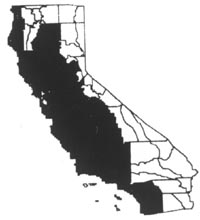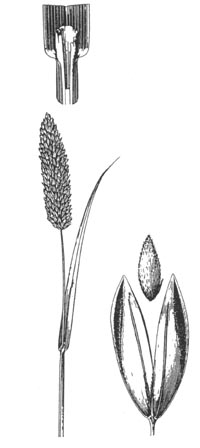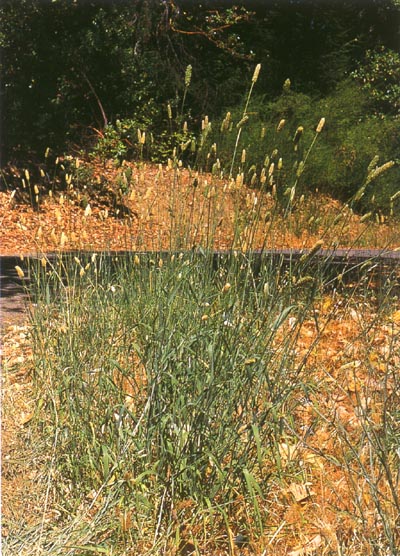|
Phalaris aquatica
|
|
|
|
Scientific name
|
Phalaris aquatica
|
|
Additional name information:
|
L.
|
|
Common name
|
Harding grass
|
|
Synonymous scientific names
|
Phalaris stenoptera, P. tuberosa var. stenoptera
|
|
Closely related California natives
|
4
|
|
Closely related California non-natives:
|
5
|
|
Listed
|
CalEPPC List B,CDFA nl
|
|
By:
|
Kerry Harrington,Thomas Lanini
|
|
Distribution
|
|
HOW DO I RECOGNIZE IT?
Distinctive features:
|
Harding grass (Phalaris aquatica)
is an erect, waist-high, stout perennial grass with grayish to bluish green
leaves. Flowering heads are dense, spike-like, and usually two to five inches
long. It is slow to develop from seed, but can form large bunches after several
years. Harding grass is similar to three other species: littleseed canary grass
(Phalaris minor), canary grass (P. canariensis), and reed canary grass (P.
arundinacea). Unlike these other species, the base of the Harding grass stem
often produces a reddish sap when cut. The other three species have winged
glumes, although the wing is widest in the upper third of the glumes of
littleseed canary grass and canary grass (Wheeler et al. 1982). The wing margins
of littleseed canary grass usually have tiny teeth, whereas the margins are
entire in the other two species. Both littleseed canary grass and canary grass
differ in that they are annuals, they commonly have shorter inflorescences, and
they lack the tuberous swelling often found at the base of the stem of well
established Harding grass plants. Reed canary grass (P. arundinacea) differs
from Harding grass in having more distinct rhizomes and an inflorescence that is
compact at first but later becomes more open as the branches spread. Hybrids of
Harding grass and reed canary grass have been produced.
åÊ
|
|
Description:
|
| Poaceae. Perennial, tufted, erect, deep-rooted, rather stout grass, 3-4 ft (1-1.3 m) tall. Leaves: blades grayish to bluish green, rolled at emergence, 4-15 in (10-40 cm) long, 0.25 to 0.75 in (6-18 mm) wide, hairless, with membranous ligules 0.10 to 0.40 in (3-10 mm) long and no true auricles. Inflorescence: dense, cylindrical, spike-like, 2-5 in (5-12 cm) long and 0.6 in (1.5 cm) broad, becoming narrower toward the tip. Primary and secondary panicle branches very contracted, with numerous short-pediceled spikelets. Spikelets 0.20-0.25 in (5.5-6.5 mm) long, laterally flattened, all similar, and at maturity not falling entire but disarticulating above persistent glumes. Three florets per spikelet, only the uppermost fertile, lower two reduced to sterile lemmas. |
|
Glumes almost equal, membranous, the length
of the spikelet and enclosing it, 3-nerved, strongly keeled along the mid-nerve
with a row of short spines on the back in the upper half; lateral nerves also
prominent, green, margins papery and white. Two sterile lemmas reduced, narrow,
pointed, curved, and hairy, about 0.06 in (1.5 mm) long, not supporting paleas.
Upper lemma 5-nerved, rounded, and fairly densely hairy on the back, becoming
shiny at maturity, about 3/4 the length of glumes. Palea faintly 2-nerved,
nerves close together along the mid-line, hairy in upper half on back between
nerves. Three anthers, 0.10 in (2.5 mm) long (Tothill and Hacker
1983).
åÊ
|
|
WHERE WOULD I FIND IT?
|
Harding grass is widespread in California
because it has been used as a forage species and for revegetating after fires.
It is most common in coastal valley and foothill grasslands from Oregon to the
Mexican border. It is also found in the Sacramento and San Joaquin valleys at
elevations below 4,000 feet (1,200 m). Harding grass is typically found along
roadsides that are seldom defoliated, allowing this tall, erect, leafy plant to
dominate neighboring vegetation. It is also frequently found beside ditches and
streams because it tolerates wet soil conditions. However, it also tolerates dry
conditions because of its deep root system. It can be found on a wide range of
soil types, growing best in high-fertility conditions but tolerating
low-fertility soils (Lambrechtsen 1992).
åÊ
|
|
WHERE DID IT COME FROM AND HOW IS IT SPREAD?
|
Native to the Mediterranean region, it has
been dispersed throughout the world by agronomists and farmers for its value as
forage in pastures. Its main agronomic value is its ability to tolerate
conditions of low moisture, heavy grazing, and winter pugging by livestock
(Langer 1990). Once planted widely for forage, it continues to colonize new
areas through spread by seed. Seeds are disseminated short distances primarily
by wind and by animals, while long-distance spread is through human
activity.
åÊ
|
|
WHAT PROBLEMS DOES IT CAUSE?
|
In wildland habitats Harding grass
outcompetes and displaces native plant species. Tall stands of its dry foliage
can present a fire hazard in summer. Although valued as a forage plant, it can
cause a condition known as ÛÏstaggersÛ in sheep. Staggers is characterized by
respiratory distress, poor muscle coordination, and even death in some animals.
Harding grass is less palatable to animals when plants are mature (Langer
1990).
åÊ
|
|
HOW DOES IT GROW AND REPRODUCE?
|
Harding grass reproduces by seed. Flowering occurs in May and June, as soils dry after winter rains, with viable seed formed between May and September. A significant amount of seed is produced each year by established plants, up to 40,000 seeds per square meter under some conditions (Reddy et al. 1996). However, seed production varies considerably with plant density, soil type, and weather conditions.
It is not known how long seed remains viable in the soil. Seeds will germinate whenever moisture is available, although germination rates decrease as temperatures drop below 50 degrees F (10 degrees C) or rise above 85 degrees F (30 degrees C) (Charlton et al. 1986). Seedlings will establish successfully only if there is minimal competition. Although Harding grass is an aggressive competitor once established, it has weak growth as a seedling.
Harding grass can tolerate some shade but prefers open ground. Although it can tolerate dry conditions, it typically goes dormant over summer if moisture is limited, as in most areas of California, then recommences active growth with fall rains. Plants grow actively through autumn, winter, and spring, producing much new seed in spring before the onset of dry conditions. Individual plants can spread laterally by production of short rhizomes (underground stems), allowing clumps to form, but this spread is minimal compared with reed canary grass, which has a much more extensive rhizome system.
|
|
Physical control:
|
Mechanical methods: Cultivation is generally not an effective
method of control because Harding grass produces an abundant seedbank and can
also regenerate from short pieces of rhizome left in the ground. Repeated
cultivation when plants are actively growing would be necessary. Active growth
corresponds to the time of frequent rainfall, which limits the ability to
cultivate. However, cultivation may be used to remove a flush of seedlings and
reduce the seedbank.
Mowing: Kay (1969) observed that close mowing or clipping late
in the growing season can greatly reduce the vigor of Harding grass. Mowing
should be done when plants are still green but seasonal soil moisture is almost
exhausted.
Prescribed burning: Although most studies on burning Harding
grass were seeking to increase its productivity, burns made after mid-January
were injurious to this species. Injury may have resulted from damage to young
shoots. Recovery from fire was slow.
Mowing and irrigation can be used to stimulate new growth of
Harding grass. New growth can then be treated with glyphosate or fluazifop,
resulting in high mortality. Grazing can be used in place of mowing, but in
either case, at least ten to twelve inches (25-30 cm) of regrowth is needed
before an herbicide application.
åÊ
|
|
Biological control:
|
Insects and fungi: No insects or fungi are known to be effective
in controlling Harding grass.
Grazing: Livestock or geese can help to reduce the abundance
and/or vigor of Harding grass. Grazing alone would not be expected to provide
sufficient control. However, mob stocking (high numbers of livestock in a small
area) or confined grazing with geese (grasses are the preferred food of geese)
could be used in combination with other treatments to reduce Harding grass
infestations.
Competition: Once Harding grass plants have been killed, new
seedlings will soon establish if the soil is left bare. However, young seedlings
are susceptible to competition, which is why Harding grass pastures can be
difficult to establish (Langer 1990). To prevent reestablishment in habitats
where Harding grass is not wanted, desirable species should be planted that will
smother seedlings as they germinate. If broad-leaved species or fine fescues are
planted, fluazifop can be used to selectively remove any young Harding grass
seedlings that manage to emerge.
åÊ
|
|
Chemical control:
|
Post-emergence control: Spot treatment with
a 2 percent solution of glyphosate applied as a foliar spray to actively growing
plants will kill Harding grass (Parsons 1992). A broadcast rate of 1.5 to 2.0 lb
ai/acre is effective for large infestations. Ideal timing for this treatment is
either at the early heading stage of development (mid- to late spring) or in
early fall. Fluazifop at 0.25 to 0.375 lb ai/acre will kill actively growing
Harding grass. Harding grass that is suffering from water stress will not be
controlled. Activity is slow with this herbicide, often taking two to four
weeks. With both fluazifop and glyphosate, repeat applications should be made if
regrowth occurs or to control plants not killed by the first treatment.
Preemergence control: Sulfometuron applied at 2.25 to 3.75 oz
ai/acre provides good control of Harding grass. Applications to the soil must be
made prior to the start of seasonal growth. This highly active herbicide must be
moved directly into the soil by rainfall or irrigation to prevent offsite
movement. Bromacil, hexazinone, and simazine are other preemergence herbicides
that provide good control of Harding grass. Both bromacil at 5.5 to 8.5 lb
ai/acre and hexazinone at 3.0 to 6.0 lb ai/acre can provide control of seedling
and established Harding grass (OÛªConner 1996), while simazine is effective only
for germinating seedlings. Use of these preemergents is limited primarily to
non-crop sites, and they must be applied prior to the initiation of Harding
grass seasonal growth.
åÊ
|



